
It’s often difficult to get a feel for the composer behind the baton, piano, writing desk or pile of fading sheet music. Vienna’s Beethoven Museum, however, makes it easy.
- Explore his life, works, legacy & character
- Beethoven likely lived here in 1802
- Focus on his Vienna years (1792 – 1827)
- Book a concert experience* for Vienna
- See also:
- Classical concerts in Vienna
- One-time free entry with the Vienna All-inclusive Pass
Inside the museum
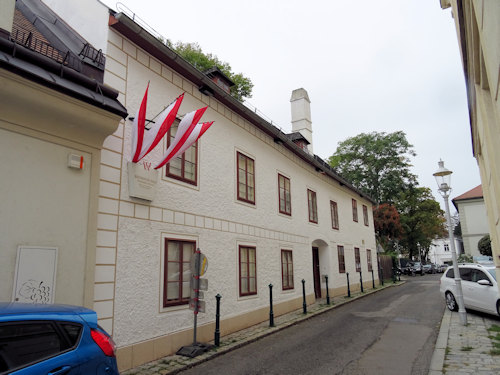
(A must-see for Beethoven aficionados)
One of Beethoven’s most moving works is, surprisingly, not a piece of music, but a letter: the Heiligenstädter Testament.
He rages against his growing deafness in the missive, though his dark thoughts eventually give way to a determination to continue creating and writing.
Beethoven wrote that letter in a house in a small country village (called Heiligenstadt) just outside of Vienna, where he spent the summer of 1802.
He also worked on, among other things, the Eroica variations (Op 35), his third symphony (Eroica – Op 55), and the Tempest sonata (Op 31 Nr 2) at the same location.

(Part of the Heiligenstädter Testament, 1802, Ludwig van Beethoven; press photo © Staats- und Universitätsbibliothek Hamburg, Signatur: ND VI 4281)
Two centuries later, and Vienna has long swallowed up Heiligenstadt, though it remains one of the more relaxed, less urban parts of the city; you wouldn’t normally find your way out there on any conventional tourist routes.
And that house has become the Beethoven Museum, one of several musician residences run by the Wien Museum.
At least, the museum is probably in that house.
It’s hard to be 100% certain of the exact address he stayed at when out in the country: computer records tend not to go back to 1802.
Regardless, the museum features a wonderful collection of displays that bring the man and his music to life.
The premises (a former country bakery) surround a small courtyard and feature six display areas, each no more than a room or two in size, their white walls and wooden floorboards adding to an air of authenticity.
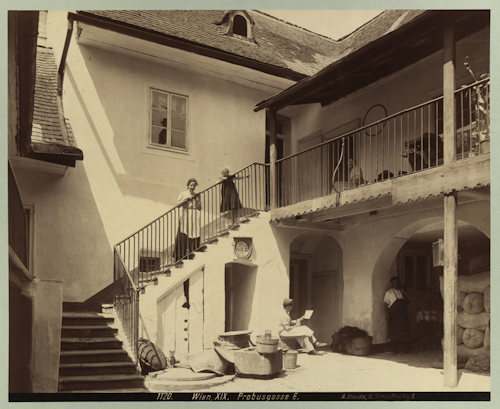
(Beethoven’s apartment in Heiligenstadt – courtyard view around 1902, photographed by August Stauda; Wien Museum Inv.-Nr. 27668; reproduced with permission under the terms of the CC0 licence)
Each area tackles a different theme:
- Arriving: Beethoven’s time in Bonn and his arrival in Vienna in 1792
- Rejuvenating: on Heiligenstadt and Beethoven’s love of the countryside (and how that fed into his compositions)
- Composing: his creative process and environment, as well as the role played by his gradual hearing loss
- Earning: his position in society and his patrons
- Performing: venues for music in the Vienna of the time (in the days before formal concert venues dominated)
- Bequeathing: his death and legacy
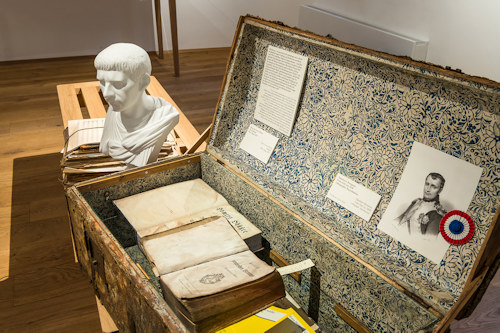
(View of part of the “arriving” exhibition; press photo by Klaus Pichler and © Wien Museum)
These are all just words.
What you really get in just a short hour or two is Beethoven’s personality brought to life through pictures, videos, book and journal excerpts, and much more.
You won’t come out with an encyclopaedic knowledge of his career or output, but you should emerge with a (possibly sad) smile and a real understanding of Beethoven: man, genius, cantankerous artist, and legend.
And, of course, you have plenty of music to listen to along the way.
My favourite bits were the quotes and anecdotes from the man himself and from his friends and contemporaries. For example, an angry Beethoven allegedly said to his patron, Prince Lichnowsky:
There are and will be a thousand princes; there is only one Beethoven.
…such a delightful mixture of revolutionary spirit, arrogance, and contempt. Genius, eh?
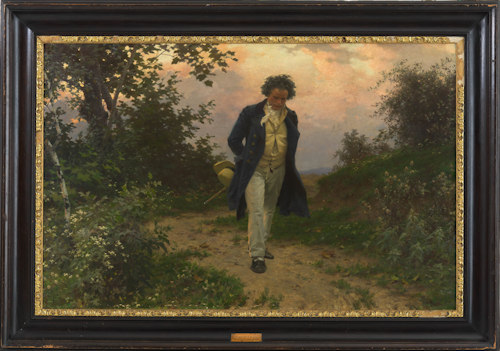
(Beethoven out for a country walk. The painting by Julius Schmid from around 1901 normally hangs in the museum; Wien Museum Inv.-Nr. 28002; reproduced under the terms of the CC BY 4.0 license; photo by Birgit und Peter Kainz)
Other highlights:
- I always get a kick out of every map or landscape drawing of the time. The museum was just a bakery on an empty country lane back then. Today, well, my kids went to Kindergarten in the house opposite.
- A copy of the flyer announcing the first major music performance Beethoven organised, which includes the note (I paraphrase):
Tickets also available from Mr Beethoven at his apartment…
Imagine nipping up to Ludwig’s flat after work to pick up a couple of tickets. “Seats near the front, Mr B, if you please. Any chance of a coffee?”
- Beethoven’s little moan about the spa treatments he received. You can almost imagine the frown at each fresh mouthful of warm water. Can’t help but feel he was an irascible grump and, therefore, a man after my own heart.
- Headphones that let you experience the way Beethoven’s hearing deteriorated over time. Fascinating and strangely moving.
(The Haus der Musik in Vienna’s center also has an installation that explores Beethoven’s loss of hearing.)
The final video installation really brings home the extent of his lasting influence beyond the sphere of classical music.
Discover references in, for example, modern music (e.g. Chuck Berry), literature (e.g. A Clockwork Orange) and even politics (e.g. Bernstein conducted Beethoven’s 9th symphony at the 1989 concert celebrating the fall of the Berlin wall).
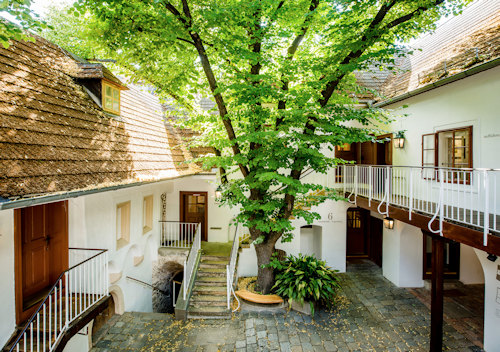
(The courtyard; press photo by Kollektiv Fischka/Kramar and © Wien Museum)
Tickets & visitor tips
At the time of writing, an adult ticket cost €8, with concessions available, including one-time free entry with, for example, a Vienna All-inclusive Pass from Go City (see my review). All display information is in English and German. Some tips:
- Pop out into the garden, too, where you can sit in the shade of an apple or walnut tree and listen to the Septet in E-flat major, originally dedicated to Empress Maria Theresa.
- The shop is more extensive than in most of the musician sites in Vienna, with a range of Beethoven-flavoured souvenirs, books, CDs, postcards, and even Beethoven wine on my last visit.
- A little bit of a walk to the west takes you to another former Beethoven residence: the (private) Beethoven-Grillparzer House once witnessed the coincidental coming together of two of the city’s great creative minds.
How to get to the Beethoven Museum
Beethoven failed to think of 21st-century visitors when he decided to take summer retreats out in the actual country, rather than close to the city centre where subway stations would eventually be built. Shame on him.
The 37A bus does pass close by (get off at Fernsprechamt Heiligenstadt or Armbrustergasse). Catch that bus from the Heiligenstadt station, which is on the U4 subway line.
Alternatively, take the 37 tram from the city centre (starts at Schottentor), then get off at Hohe Warte and walk down.
Address: Probusgasse 6, 1190 Vienna | Website